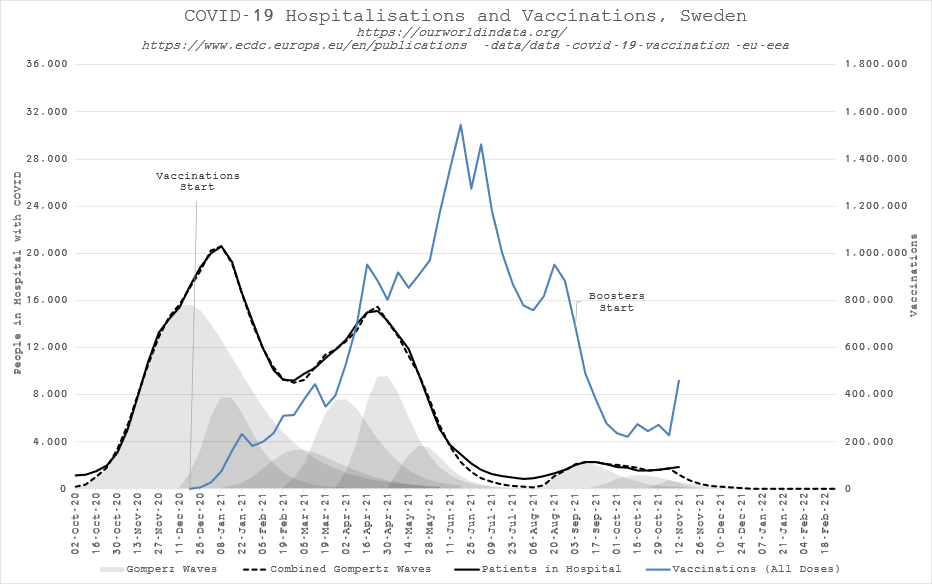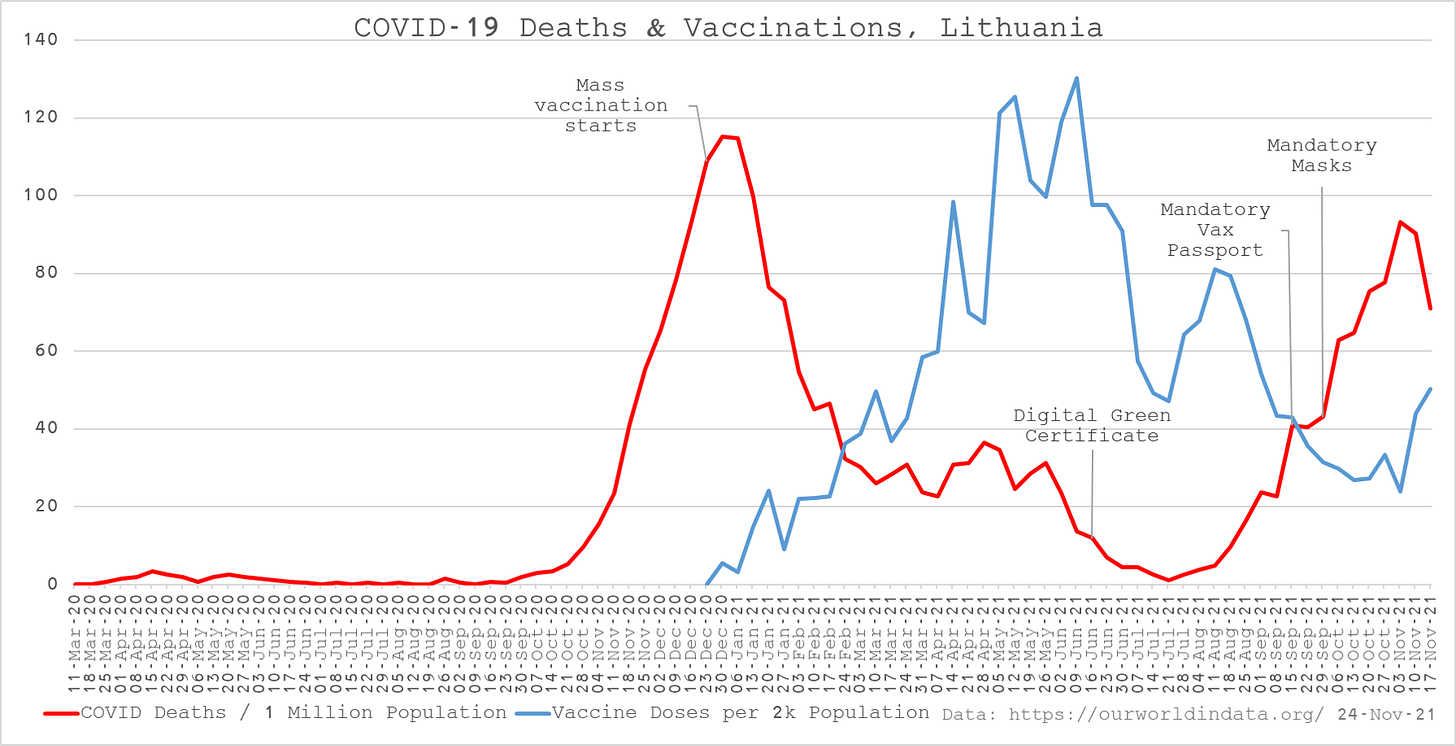Empirical tests of COVID NPIs
Examination of the impact of masks, lockdowns, vaccines and vaccine passports on COVID hospitalisations and deaths in Northern Europe.
Last year, we had to resort to sophisticated modelling to determine if non-pharmaceutical interventions (NPIs) had a positive impact on the only COVID metrics that matter - hospitalisations and death. In spite of this, we did a very good job of demonstrating that social distancing measures, lockdowns, community masking, etc. made no discernible difference whatsoever. We certainly didn’t see anywhere near as much effort or evidence to support them.
This year we have more complete data and the possibility to make comparisons for a single country during periods with and without the NPIs. This allows us to produce information based on simple, empirical statistics rather than models.
I go one step further. The NPI policies are supposed to be very effective and they are not without considerable collateral harm so their impact should be evident just by looking at clear, graphical representations of the data. There should be no need for statistics for the ordinary person to judge for themselves.
So, in this report, I’m going to use Sweden, Czechia, Austria and Germany to depict the impact of COVID vaccines on hospitalisations; and Lithuania, Estonia, Latvia, Denmark and Sweden to depict the impact of masks, lockdowns, vaccine boosters and passports on COVID deaths.
Starting with Sweden, whatever your thoughts on correlation vs causation and its pandemic approach before mass vaccination, it is difficult to ignore the waves of COVID hospitalisations that are concomitant with vaccination rates.
I said I didn’t need to use modelling but you don’t really need the Gompertz waves to help you recognise the phenomenon that is almost ubiquitous around the world. What we do see just in the final week is the beginning of a rise in COVID hospitalisations. Although this is once again concomitant with a rise in vaccinations, it is the start of the “season” so we maybe shouldn’t read too much into that. Sweden then, is a reasonable control, with significantly less COVID hospitalisation since October, compared to the same period in 2020.
Moving directly south to Czechia, we see a different pattern entirely. At the end of the data, we are around half the level of hospitalisation of the previous year. It was at this point that hospitalisations peaked. Could this be an indication of vaccine effectiveness in reducing hospitalisations? If my modelling is correct (and so far it is spot on) then we could be looking at a Xmas peak around two-thirds as high.
But let’s just put a couple of caveats on this. Firstly, we should expect hospitalisations and deaths to be lower. We are not so naive as to deny natural herd immunity, nor to ignore the fact that a lot of the most susceptible have already succumbed. So, we shouldn’t be too hasty in notching one up in favour of the vaccine.
Moreover, we cannot ignore, once again, this concomitant rise of hospitalisations with vaccinations. Unfortunately, it’s a word I use a lot but only through necessity! Could it just be a coincidence because you vaccinate in preparation for the “season”? Perhaps, the timing is just a little too late in that case because they did not anticipate the waning of vaccine protection, such that it was?
I’ll jump in defence of my model and draw your attention to the apparent dip in vaccination. If there is a positive, causal relationship between vaccinations and hospitalisation then we might see hospitalisations finally fall beneath my model forecast, just as they did in the UK summer when we opened up at the same time as slowing down vaccinations. How curious.
To be honest, and no disrespect to any Czechs, I only looked at Czechia in comparison to Austria when they first announced a return to Nazi policies of persecution and discrimination in their treatment of the unvaccinated.
Ignoring the well-established and accepted scientific fact that the vaccine does not stop you catching or spreading the virus, the media commentators supporting the narrative insisted that Austria’s autumn woes were due to poor vaccine uptake, justifying thier intent to lockdown the unvaccinated.
Alas, no-one in the Austrian COVID taskforce or the media thought to check the charts, nor did the army of “fact checkers”. If they had, they might have seen one of the most striking relationships between vaccinations and hospitalisations in Europe, no more so than since the start of the boosters in August when, incidentally, Austria was actually one of the leaders.
This time my modelling skills appear to have failed me slightly. But I might yet be redeemed next week if hospitalisations coincidentally follow the decline in vaccinations?
Never to be outdone in such matters, the Germans appear to be following suit with Austria in their discrimation of ther unvaccinated, not wanting to catch up with Austria’s poor hospitalisation record.
Alas, the only intervention they already have in common with Austria appears to be having the opposite effect. Another dent in my modelling credibility or is this coincidental rise between vaccinations and hospitalisations more than just a coincidence when we see it in so many different countries at so many different times?
Across the board then, we appear to have lower hospitalisations in these four countries than last year. Whether or not this is because of or in spite of vaccinations remains unclear. In terms of policy, especially one with significant adverse side effects, cost, coercion and even mandate, “unclear” is very much a failure in my opinion.
At least hospitals are not overwhelmed with COVID patients but what about deaths?
Let’s start with Lithuania because they have literally thrown every coersive measure, new and old, at mitigating COVID. How does their COVID mortality compare to last year?
Ah, well clearly not so good. But maybe there was some other reason why they got virtually no COVID until last autumn. You know, like physical geography perhaps? Can’t really accept such a dramatic shift as a result of behavioural change, really, can we?
But we do have last autumn to compare to this autumn. And what have they done differently? Well, they have vaccines, of course. They are also the most draconian enforcer of vaccine passports so that should be a good test of the narrative that this is a “pandemic of the unvaccinated”? And once again, they have brought back the measure with probably the very least effectiveness or scientific rationale - community mask-wearing.
The result? Considerably more COVID death than last year. Chalk one up for the NPIs because imagine how bad it might have been without them? Well, I think we should all be allowed to make our own judgement on that and act accordingly, by which I mean volunatarily. If you think your mask, vaccine and persecution of those who don’t think and act like you is keeping you from a COVID death, by all means wear your mask, wear two or even three, have your jabs, three or even four, stay at home and lock the door. But don’t impose your irrationality on others.
Am I being unfair? Shouldn’t we at least compare Lithuania to its neighbours? There are plenty of confounders for sure but a relative comparison of last year and this might be somewhat useful?
Estonia looks somewhat similar. The coincidental rise of vaccinations and deaths in December last year is more obvious. They went earlier and harder on the mask mandate this autumn. They have three times as much death as this time last year and as much as the winter peak which may or may not have been adversely affected by the vaccination rollout. Still not seeing any dramatic reductions in mortality though?
Much the same picture in Latvia too. The major policy difference here is that they claim the title of being the first country in Europe to enter a full lockdown this autimn. The result after 10 months of vaccinations, passports and another lockdown? Seven times more death than last year. I don’t know about you but I’m beginning to get the feeling that none of these measures are really as effective as the narrative claims.
What about across the Baltic Sea? Well, Sweden, of course, has none of these draconian measures. And they don’t have any COVID deaths either. I mentioned already that they have only just started vaccinating again so that could change (or it could just bve a coincidence). Maybe it’s because they already had all their death last spring and winter and my argument about natural herd immunity and size of the susceptible population has some merits after all? Who knows?
Just for good measure, let’s throw Denmark into the mix as well. Anything to see here? Not really. Since 3rd Nov is starting to look a little bit coincidental though…?
There you have it then. In terms of obvious empirical impact of the various pharmaceutical and non-pharmaceutical interventions, do we have a clear picture of benefit showing? I know my eyes don’t deceive me. What about yours?
If your eyes aren’t, what is?













Thank you for your hard work and for sharing this analysis!